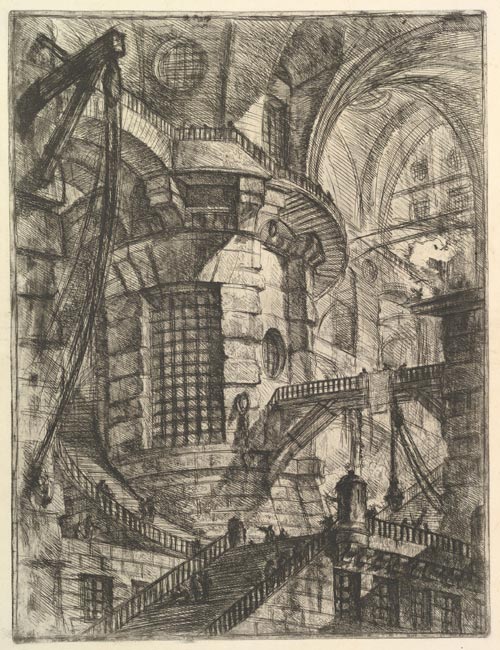Showing all posts tagged: Susanna Clarke
Susanna Clarke’s Piranesi: an introvert on steroids?
27 May 2022

Detail from Imaginary Prisons, by Giovanni Battista Piranesi, courtesy of The Metropolitan Museum of Art.
Warning, spoilers follow. Return to this article once you’ve finished reading the book.
Imagine you live in a sprawling multi-storied house. The lower levels are flooded by an ocean, while the upper floors are shrouded in mist and clouds. The seemingly endless labyrinth like hallways are adorned with classical style marble statues, and for whatever reason, sea birds have taken to nesting among some of these figures. But it’s not really a house you’re in, it’s more like a complex with the dimensions of a city, and one none too small at that.
This is the world, Piranesi, the titular character in the second novel of British author Susanna Clarke (published by Bloomsbury Publishing, August 2021), finds himself in. Piranesi knows little about how the house came to be, or when he arrived there, although he has vague recollections of living elsewhere before. Come to that, Piranesi knows hardly anything about himself. He’s perhaps aged in his mid-thirties, and if pressed, couldn’t even be sure his name was Piranesi.
Despite these peculiar circumstances, Piranesi otherwise seems content, and goes about his day to day life as if nothing were amiss. But how would you feel were it you in Piranesi’s place? Wouldn’t you wonder how you ended up in this predicament, and whether there was a way leave, and return to the real world? Wouldn’t you miss family and friends, and wonder if they felt the same way? Wouldn’t you crave the company of others at least some of the time?
But Piranesi doesn’t appear to be the least bit perturbed. Why though? Does he have some sort of problem? Does he loathe all people, and is thankful for the sanctuary the house offers, a place devoid of humans? Or is he perhaps an introvert, who’s found his happy place? Yet Piranesi isn’t completely alone in the house. Once or twice a week, he goes to a certain area of the complex, where he briefly meets a middle-aged man, whom Piranesi refers to as The Other.
If Piranesi knows little about himself, he knows even less about The Other. He has no idea who this gentleman really is — although he believes him to be some sort of academic — nor does he know where The Other resides in the house. The Other meanwhile frequently questions Piranesi, and even sets him tasks, some relatively arduous. One such request required Piranesi to walk to a distant point in the house, on a journey lasting two days return.
To make a comparison, and better understand the scale of the house, I looked up the walking time and distance from Sydney’s CBD to the western suburb of Penrith on Google, and was advised the trek is approximately fifty-six kilometres in length, and the non-stop walk would take almost twelve hours.
Of course the question of exactly what sort of place Piranesi finds himself in came up repeatedly as I read the novel, particularly as he never encountered anyone else — at least not at first — in the sprawling complex. While plenty of Clarke’s readers (myself included) have ideas as to the nature of the house, and what it really is, I found myself wondering how Piranesi could remain oblivious to his acute isolation, and not miss the company of other people.
After all, surely not even the most extreme of introverts would continuously crave the deep solitude of the apparently empty house. But there were indications Piranesi was lonely. He regarded the sea birds nesting in the statues in some of the hallways as friends, and would often have conversations — albeit one-sided — with them. But when it becomes obvious another person is lurking, out of sight, in the house, Piranesi is keen to find out who they are.
In trying to understand Piranesi’s apparently people averse personality, I would describe him as an introvert. But no ordinary — if there is such a thing — introvert. To live alone for years in a vast complex, spending perhaps an hour at most, once a week, with one other person could not be anyone’s ideal. While it can argued something else is going on, that he is unaware of, Piranesi’s outright acceptance of his plight remains compelling. Piranesi is certainly an introvert, but he’s more, he’s an introvert on steroids.
RELATED CONTENT
fiction, introversion, novels, psychology, Susanna Clarke
Piranesi, by Susanna Clarke
15 November 2021

Not that it’s my intention to traumatise you with the workings of my subconscious, but the premise to Piranesi (published by Bloomsbury Publishing, August 2021), by British author Susanna Clarke sounds like the sort of dream I might have. The setting is an old, dilapidated multi-level building, and is home to the titular protagonist known as Piranesi, who refers to the enigmatic structure as the “House.”
And dream-like is the best way to describe the dwelling. An ocean floods the lower levels of this labyrinth, providing food and fuel – in the form of seaweed – for Piranesi. The sprawling hallways of the house’s mid-section stories are lined with statues, while the upper floors are shrouded in clouds. Save for an old scholar, whom Piranesi calls the “Other”, who makes brief appearances a few times a week, the building is otherwise deserted.
But one day Piranesi begins to notice messages chalked onto walkways around the House. Do they point to the presence of a third person within the building? The Other sees them a portent of bad things to come. In order to discover the identity of this mysterious third person, and what they want, Piranesi will need to learn more about the House and its history.
RELATED CONTENT
fiction, Susanna Clarke, TBR list, writing
